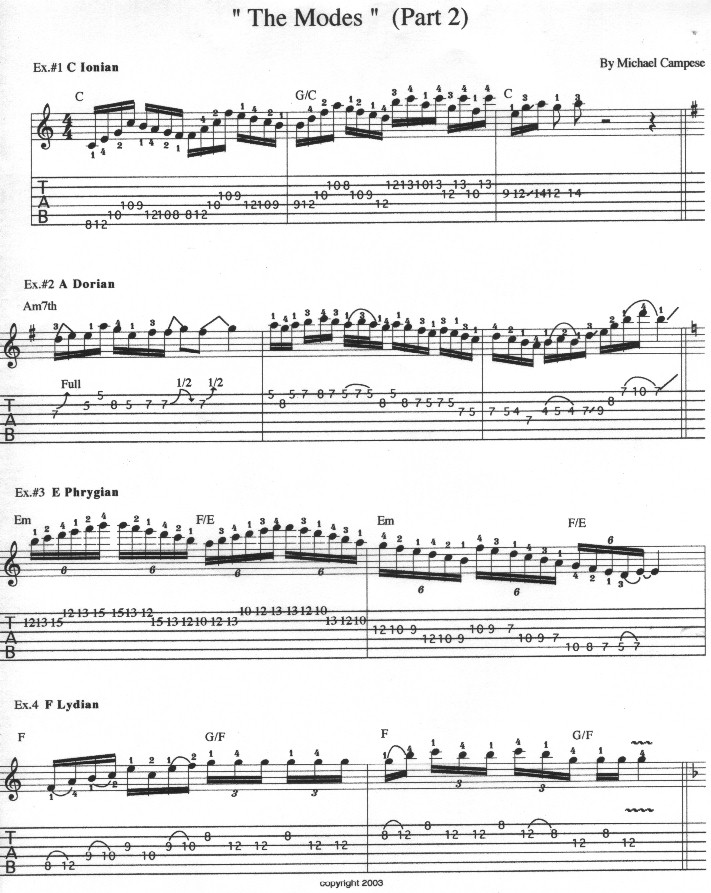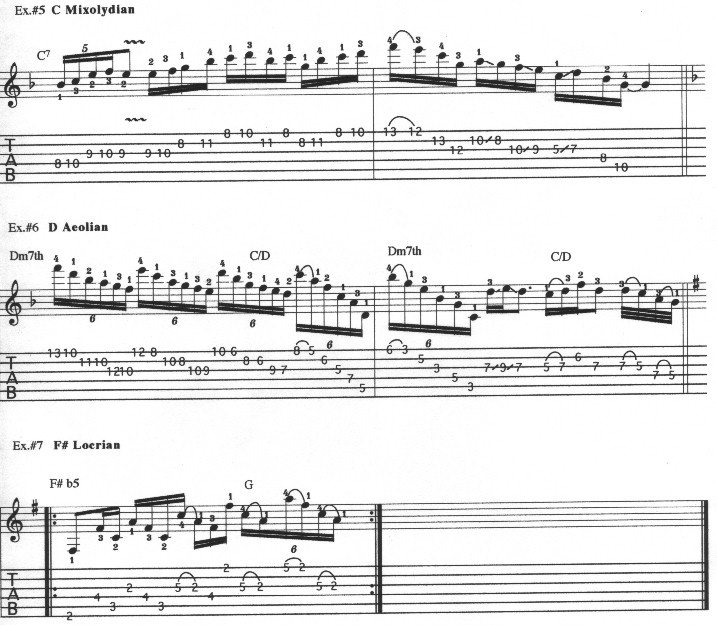Welcome back! Now you should be ready for Part 2 of the lesson on modes. Hopefully you took the time to memorize each mode and had a chance to experiment with them. In this lesson we will put the modes to use. I constructed a bunch of licks in different keys using each mode. Also, I recorded the chords behind each lick so you can hear their unique flavors. You have to get the sound of them in your ears. OK, here are the examples.
Example 1 is a lick in C Ionian, better known as the C Major scale. You will notice it has a happy quality. This lick uses a cool sequence that moves up the scale using arpeggios in C major. It has a very classical feel. It is played over the C and the 5th chord (G); the C note is ringing over both chords to bring out the Ionian flavor. Also, don't forget that G/C means G chord with a C note in the bass.
MP3 - Example 1
Example 2. Here we have a lick in A Dorian (A, B, C, D, E, F#, G), which is the 2nd mode of a G major scale. This mode has a dark flavor and a bit of brightness, due to the Major 6th. If you studied Part 1 of our last lesson you would already know this. This one is played over an A minor7th vamp. Try this one over a blues or rock progression.
MP3 - Example 2
Example 3 is a shred lick from our 'Spanish' sounding mode, Phrygian. Here we are in E Phrygian (E, F, G, A, B, C, D), the 3rd Mode of a C major scale. It is played over an E and am F chord with the E in the bass; this gives us a flamenco-style sound. Make sure you play this one very precisely, and make sure you use alternate picking.
MP3 - Example 3


Example 4 is from our 4th mode Lydian, in F (F, G, A, B, C, D, E). So again, we are simply using the same notes found in a C major scale. Lydian has a very unique sound to it. The 4th gives it a mysterious flavor; you tend to hear this scale in movies a lot. This lick is played over an F and a G chord; remember we are using the same chords from the C scale. But we are keeping the F in the bass to establish the Lydian flavor.
MP3 - Example 4
Example 5. Now we are on to our 5th mode, Mixolydian. We are using the C Mixolydian scale (C, D, E, F, G, A, Bb). It shares the same notes as the parent key, F major. This mode is mainly used over dom7th chords, major, and power chords. In this example, it is played over a C 7th vamp. It's very similar to the Major scale, but it has a flatted 7th. Make sure you follow the fingerings on this one; it will be easier to play the slides in the last bar. This lick can be used in rock, blues, funk and jazz settings.
MP3 - Example 5
Example 6. Next up is our sad sounding mode, the Aeolian mode, also known as the natural minor scale. We are using D Aeolian (D, E, F, G, A, Bb, C). Again, it uses the same notes as our Fmaj scale. It starts off with a 6 note pattern on the first 3 strings. You might want to use sweep picking for the Dm7th and C7th arpeggios, starting on beat 4 of bar one. This lick is played over a Dm7th and C/D chord. You can apply this example to many different styles of music.
MP3 - Example 6
Example 7. Our final mode, the Locrian mode, is a very dark sounding scale. Here we are using F# Locrian (F#, G, A, B, C, D, E), the 7th mode of a G maj scale. This lick is based off a F#m7b5 arpeggio (F#, A, C, E), built off the root of the F# Locrian mode. It uses some string skipping. This one sounds cool when you move it up and down the neck. You will hear this scale in many different styles of music. I applied it to a more heavy rock setting. Basically, the F#b5 chord I used is a octave with a tritone added, which would be a C note in the key of F#.
MP3 - Example 7
OK, this wraps up our lesson. Make sure you experiment with the modes; make up some licks to get the sounds of the modes in your ears. Next time we will talk more about differant chords you can use and some chord progressions. If you have any questions feel free to email me. You will hear the modes in my music, so be sure to check out my CDs on this amazing site and check out my new CD release, "Vibe". Visit mikecampese.com for more information.
Mike Campese is an all-around music performer, session artist and teacher competent in many musical styles, electric and acoustic. He has studied at G.I.T. (Honors Graduate), and with Paul Gilbert, Norman Brown, Stanley Jordan, Scott Henderson and Keith Wyatt.